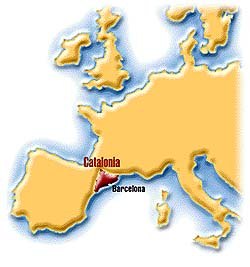Motorcycling the Mediterranean
Catalonia is a jewel-like country filled with a rich history, breathtaking scenery and friendly inhabitants. Nestled in the northeast corner of Spain, Catalonia boasts a wide variety of natural terrain including golden beaches, towering mountains and dense swampland -- all contained within its small (32,000sq km) area. For the motorcyclist searching for a mix of culture, scenery, great food and twisting roads, it may just be a dream come true.
Founded in the ninth century by the Franks as Marca Hispancia, Catalonia's history, culture and architecture have since been influenced by several societies, including Roman and Greek. Such a diverse and lengthy background has created a unique population, as well as a fascinating variety of architectual styles. Even more enjoyable is the huge assortment of culinary dishes. Most villages proudly offer forth meals native to their region. Delicious local specialties like Conill amb allioli (rabbit with a Catalonian sauce) in Catalonia's interior, or Arrrs a banda (black rice with cuttlefish) on the coast, make the trip worthwhile on their own.
After a brief stop in Ripoli to see the beautiful stone craftsmanship of a Romanesque church, we took the N152 to Ribes de Freser. This is where serious fun begins as the 30km road is full of bends and stunning mountain views. A great opportunity to really enjoy the Yamaha's torquey motor as it pulls strongly from corner to corner.
Travellers to this part of the country shouldn't miss the National Park of Aig estortes i Sant Maurici, which is found just off the LV5004. Public vehicles are forbidden here, so taxi-like Land Rovers will drive you through this magnificent park. If you are a fan of natural settings and tranquility, this is a definite must-see.
As we head to Catalonia's southern regions, the landscape becomes less mountainous and much drier. From Pont de Suert we ride along the C144 to La Pobla de Segur. This route passes three reservoirs, which we take advantage of with a swim to beat the mid-day heat. Continuing south, we discover the historic city of Balaguer which abounds with abbeys, churches and castles from the ninth to thirteenth centuries. A panoramic view of this magnificent city can be seen from the church of Santa Maria. Other highlights include the thirteenth century churches of Sant Lloreng, Sant Marti and La Seu Vella.
Save some film for Les Borges Blanques, which is found on the nearby Highway 240. Here we find a stunning abbey named Monestir de Poblet which holds the graves of kings and lords. As we walked through the historic abbey and its ancient tombs, we found ourselves thinking about what life must have been like for the inhabitants of this region so many centuries ago. This was one of our most favorite stops during the tour, and should not be missed.
Catalonia's "Costa Daurada," or Golden Coast region now passes under the wheels of our trusty Yamaha. This region is famous for its seafood, and each coastal village has its own specialty. We dine on "xipirons" -- fried small squid, "calamars a la romana" -- squid in batter, "sardines a la planxa" -- grilled sardines, and "escopinyes a la planxa" -- grilled seafood. With a good white wine such as Blanc Pescador or Extrisimo Bach, the experience is complete. With days spent enjoying the extraordinary culinary offerings from the villages of Torredembarra and Coma-ruga, and evenings indulging in the intense night life of Segur de Calafell, we leave this area richly satisfied.
Port Aventura offers travellers a change from the ruins and abbeys and entertains instead with a huge amusement park similar to Disneyland. We spent a full day here, exploring the many sights and checking out the rides. None of the rollercoasters matched the speed of the Yamaha though!
Lying south towards Amposta is El Delta de l'Ebre, (the Ebre river delta). This is the greatest wetland area within Catalonia and the most important aquatic habitat of the Mediterranean sea. We carve up some narrow B-roads on the way to Sant Jaume d'Eneja, where we stop for a relaxing riverboat tour of the region.
Back underway, we continue south to Sant Carles de la Rapita, the last village before leaving Catalonia and entering Valencia. We opt to stay in the village with its pristine and uncrowded beaches. An afternoon spent watching flamingos in a nearby park and shopping at local merchants makes our day complete.
Our vacation is nearing its end so we turn north back to Barcelona. But first there is one more stop to make at Montserrat's abbey. This is a very popular sight for tourists, and restaurants and souvenier shops have sprung up to take advantage of them. Founded in the tenth century by the Abat Oliva, Montserrat's abbey is greatly cherished by Catalans. Despite the flocks of tourists, the history and splendor of the abbey make it a memorable stop. Equally memorable is a sweet alcoholic drink produced by the abbey's monks called "Aromes de Montserrat." After indulging in this local specialty we relax with a ride on the mountain railway that climbs far above the abbey, and savor the magnificent view that it provides.
Funneling into Barcelona's traffic gives us a chance to reflect on our tour of Catalonia. With its fascinating ruins, historic buildings and great food we have been given many memories to cherish. While only 1,000km have passed beneath the wheels of our Yamaha, we have visited mountains, beaches and wetlands. With so much to offer, along with countless twisty roads, Catalonia may well be the world's best-kept secret when it comes to motorcycle touring destinations.






































Comments
Join the conversation